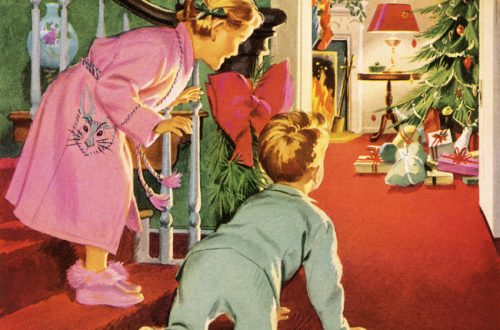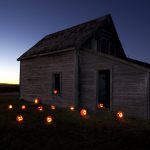You'd be crazy to cross Mr Smith's garden. But one night I had to.
In the Minnesota neighborhood where I grew up, gardens were a means of survival for low income families and old people.
Gardeners like Mr Smith had to look out for their harvests, which were often targeted by small night marauders who took real risks when thieving crabapples, a watermelon, or ears of corn. We knew Mr Smith had a pellet gun and a bad temper, and would be unsparing with both.
Mrs Smith was a rounded shadowy figure who stayed inside their small house on 31st Avenue. She could often be viewed through the front picture window, sitting silently in the living room, alone with her thoughts while her husband planted, watered and weeded in the lot next door.
Periodically Mr Smith filled a creaky child’s wagon with shoes, castoffs, and a few prized vegetables – anything that might draw a buyer – and traversed the street seeking custom.
My mother would sometimes buy a cucumber or a bunch of rhubarb from Mr Smith. I didn’t understand this as she had her own garden and grew exactly the same produce.
If she caught sight of him she would shoo us outdoors and disappear into her bedroom.
“I can’t face it today,” she would say.
In our neighborhood there was little spare cash for Mr Smith’s excess crops and wares, nor could tired mothers always summon the energy to converse with their gruff neighbor.
It’s only in recent years that I’ve realized what my mother couldn’t face wasn’t a chat with Mr Smith, but agreeing to a pity-based transaction.
Mr Smith was a seemingly comfortable loner who kept himself to himself. Mrs Smith was his only company and he hers.
I didn’t think more about Mr Smith except that he was ornery and thus to be avoided. That nonetheless he didn’t deserve to sometimes have soft tomatoes and eggs thrown at his old car or picture window by wicked little pranksters.
Mr Smith seemed to return the contempt.

On moody Halloween nights the Smiths would pull their curtains, switch off the lights, and sit together in the gloom.
We all knew there was no point knocking on their door to trick or treat. In any case, we were scared of Mr Smith.
Their curtains were thin enough that we could see them side by side on their couch, waiting for another Halloween night to pass by.
Remembering the Smiths sitting in the dark is a wistful memory, for reasons that came later.
When I was in my teens I often walked the six blocks to and from a friend’s house after nightfall.
There were fewer people in Cyndi’s house and we usually had sole command of the television. Plus she had a ping pong table and favorite records to play by — The Carpenters’ Mr Postman, Elton John’s Rocket Man, Benny and the Jets, Crocodile Rock, and so many other 70s tunes.
I always took the same route, adding two blocks so I could travel along well-lit 3rd Street most of the way apart from that last stretch, which was usually in shadows except for twinkling blankets of frost or snow on neighbors’ fallow gardens.
Recently I’d had a bizarre experience on my usual route on 1st Street, when a man in a ski mask and dark clothing popped up and down repeatedly from behind a construction dirt pile like a sinister clown straight out of American Horror Story.
I changed my routine after that night, wondering whether things were getting feral in St Cloud, Minnesota.
In my youth it wasn’t unheard of for me smoke a few Kool or Old Gold cigarettes.
On this occasion it was late when I shook one out of its pack, struck a match, and headed home.

Like many women, I’m uncomfortable walking alone in the dark. Back then, as I scuffed my boots along the slippery sidewalks, I often considered what I’d do if someone sprang out from behind one of the big old trees or tried to bundle me into their car.
My mother had had such an experience when she was young, and filled our heads with blood thumping tales about stranger danger.
As schoolgirls she and her sister had been fortunate to escape a predator who pursued them for a long distance through the remote woods behind their Alexandria farm. She relived the terror of this chase throughout her life.
“Never walk close to a strange man’s car. Don’t accept presents or candy from someone you don’t know. Always be suspicious. Keep your distance. If you’re afraid, even if you know the person, scream and run. Better to look foolish than end up in the clutches of an Ed Gein.”
The infamous murderer and body snatcher had been in prison for years by then, but if you could find an Ed Gein in the weeny town of Plainfield, Wisconsin there were probably a few psychopaths in Stearns County, Minnesota, or so she believed. Rightly enough, as it turned out.
Her concerns intensified when Susanne and Mary Reker disappeared, aged 12 and 15, on Labor Day in the autumn of 1974. Such things were unheard of in our semi-rural community and it was weeks before their bodies were found at a quarry on the outskirts of town, Mary submerged under the deep waters, Sue in scrub nearby. Both had been brutally stabbed.
Their killer or killers remain at large today.

We knew Mary and Sue.
It was and is unthinkable that the sisters, walking together in broad daylight, could meet such a fate.
Their stroll to the popular Zayre store along busy roads to buy school supplies was one Cyndi and I made many times ourselves.
Crazy stories circulated. There was a monster in our midst, and not knowing who it was did our heads in.
And walking home at night along the quiet streets, I liked the dark even less.
The old white stationwagon with the busted tail light had passed several times.
As I approached the shadowed avenue where I usually turned to sprint the final block and a half, the wagon rounded the corner, idling halfway down the street.
Years later, my mind still replays those moments, just as my mother’s creepy chase through the woods became her own lifelong subliminal reel.
This was someone who knew my route from Cyndi’s to home. Who knew enough to turn into the wintry street before I even reached the corner.
I still berate myself for walking past the driver’s door when it was clear the sole occupant of the car had parked oddly with the engine running in front of a string of sleeping houses.
The door opened. Then came the attempts to shove me onto the front bench seat, and mutterings of how if I didn’t shut up and get in he would kill me.
I thought, of course, of Mary and Sue: was this their killer?
In that split second I decided that if I was to die, I’d rather it happened right there on the street.
Fending off punches, wondering if he had a knife or a gun, I lost traction and slipped under the car.
He gave up, jumped behind the wheel and accelerated, skidding on the icy gravel. I swung away from his tires just in time.
I ran to the nearest house and pounded on the front door, worried he’d circle back for another try. But no one answered at that house or the one next door.
The quickest way to safety was through the shared yard and across the Smiths’ bare garden.
An irrational fear of Mr Smith overwhelmed the more immediate danger of being kidnapped, raped, killed. But finally my feet moved. I can still hear the crunch of my boots piercing the crust that skimmed the hard ground of Mr Smith’s pumpkin patch.
I expected to hear shouts, or feel the strike of pellets from his gun.
But there was nothing.
Not a sound except my ragged breathing and the clatter of my boots. Minutes later I was in my father’s arms.
His first words weren’t “are you okay” but “have you been smoking and drinking — admit it or the police won’t believe anything you say”.
Poor Dad.
Like all of us, he was a product of his past, caring more about what people might think of his naughty daughter than thanking his lucky stars she’d made it home unscathed. Though I’m sure this thought came later.
Within a few years he would die suddenly. It is odd to think that I am now older than he was at the time.
And unlike Mary and Sue, I lived to tell my tale.
I was told the man who assaulted me was caught and imprisoned for raping an 11 year old; he was tried for that more serious crime, so I never had to testify against him.
His stalking and targeting of me had nothing to do with the Reker case, except in my mind.
The trauma I felt for years afterward seems out of scale: I escaped, after all. But I somehow linked the incident with the murders of the Rekers.
When I revisit that night I immediately think of them, perhaps because images of Sue and Mary saved me from getting into that car.

Later there was speculation that their killer was known to Mary, and responsible for the similar kidnapping, rape and stabbing of another young girl – another Sue.
She was a cousin, a friend of my sister’s.
Her miraculous escape and recovery allowed her to identify and help to convict the two men who assaulted her.
As for Mr Smith, it took awhile for me to realize there had been no reaction to my midnight lurch through his garden because he wasn’t there.
The Smiths had shifted due to ill health.
Forgetting this salient fact was a quirk of my blind fear.
But it revived my interest in the Smiths, what had become of them, and the truth behind Mr Smith’s trusty wagon and their avoidance of costumed children every Halloween.
The answer was a simple one: like so many in Stearns County, they were poor.
When funds were low Mr Smith had little option but to flog spare goods and garden bounty to all who would buy them.
They sat in darkness on Halloween nights because they could not afford treats for themselves or anyone else.
Mr Smith was protective of his garden because they relied on it for food and coin.
And his pellet gun was, I believe, an urban myth; no one had seen it let alone been fired at, despite Mr Smith’s bluster to the contrary.
Over the years I tried to discover where the Smiths went when they left 31st Avenue. Their fate, and the identity of who killed Mary and Sue Reker, remain mysteries. The answers will always be important to me.

Halloween is not enthusiastically celebrated in New Zealand, where I have lived for many years.
But every October 31st I still display the tattered witches and bats of my childhood.
I still light candles and turn off the lights.
I think about the Smiths, motionless in their living room, and feel grateful I was able to escape to safety through their garden.
And I still think about Mary and Sue and Sue.
It is an oddly comforting ritual. After so many years their faces are as familiar to me as those of my own sisters.
I remember Mary Reker in her green coat, Sue smiling as she said goodbye to my younger sister.
Later I blow out the candles and watch my old paper decorations twirl in the breeze.
I think about the other Sue, the cousin who survived her attack only to die of cancer at 34.
Then I ask what heavenly powers there be to watch over them, and the Smiths, and all of us. All of us who have ever been afraid.
Footnote: Being stalked is sadly not a rare experience even in towns of modest size like St Cloud, Minnesota. This happened to both of my older sisters as young women, to my mother, to me, and to many others I know. Nowadays I would no doubt be offered counselling after being attacked; I certainly needed it. One night, driving Dad’s Oldsmobile, I heard bottles clinking in the back seat and spontaneously turned my head (and the steering wheel) to see if someone was hiding there. I crashed head-on into a parked truck, wrecking the only new car Dad ever owned. He didn’t say a word. Years later I finally did have counselling. “You and your mother, and Mary and Sue and Sue, were unlucky,” said the therapist. “This accumulation of frightening experiences had a profound impact on all of you, and terrible consequences for your friends. But you should know that many women never have such an experience. Reclaim your life and don’t be ruled by fear.” She taught me some helpful techniques. Yet I am unconvinced. Story after story, study after study, show that women have good cause to be wary when walking on their own after dark. Or even in the middle of an autumn afternoon, like Mary and Sue Reker. As for the sinister jumping man on 1st Street, I never saw him again. I wonder who he was. At this time of year I think about these things. Mom was right all along. Be careful out there. Such people walk among us, even in Stearns County, Minnesota.

While writing Mary & Sue & Sue I picked up Minnesota author Jess Lourey’s latest novel. Quarry Girls’ plot riffs on that period in the 1970s when Mary and Sue and Sue were attacked. Things were bad, but not as bad as Quarry Girls’ spooky plot. Recommended!
Minnesota, 1977. For the teens of one close-knit community, summer means late-night swimming parties at the quarry, the county fair, and venturing into the tunnels beneath the city. But for two best friends, it’s not all fun and games.
Heather and Brenda have a secret. Something they saw in the dark. Something they can’t forget. They’ve decided to never tell a soul. But their vow is tested when their friend disappears—the second girl to vanish in a week.
Photos Cecile Hornau, Vladimir Agafonkin, Paul Robert, Unsplash









